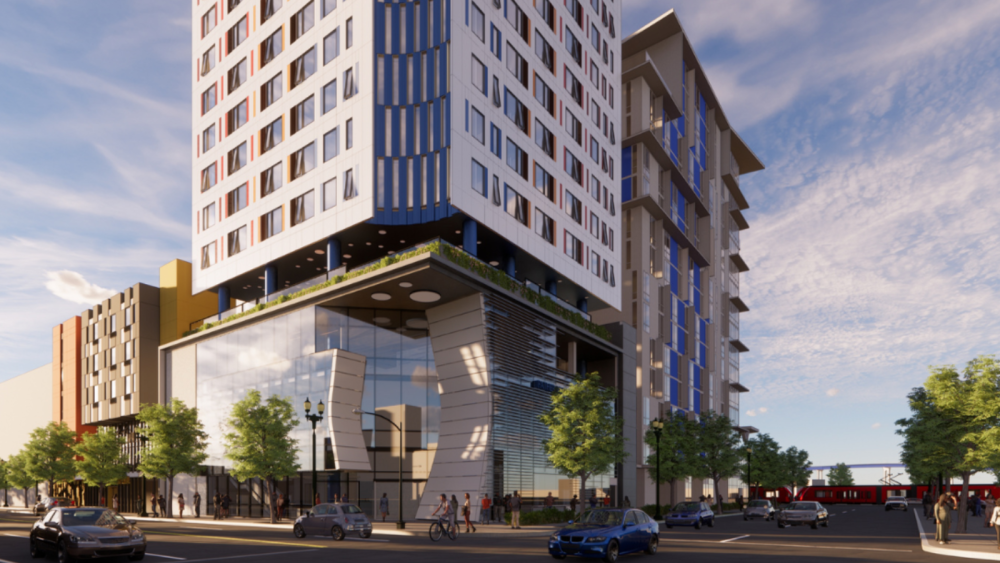City Council Approves Plan to Turn Former East Village Skydiving Facility into Fully Affordable Housing

A City-owned former skydiving facility in East Village is set to be transformed into 164 new affordable homes after today’s City Council approval of an agreement with Father Joe’s Villages outlining the terms of its sale and future redevelopment. The building, located at 1401 Imperial Ave., currently serves as the City’s Homelessness Response Center (HRC).
Last year, the City issued a Request for Proposals seeking a developer to buy and turn the building into a 100% affordable housing development. Two responses were received, and Father Joe’s Villages was selected based on the higher number of affordable homes proposed and their successful track record in the development of affordable housing.
“We’re transforming City-owned property into affordable homes, because that’s what this moment demands,” said Mayor Todd Gloria. “By partnering with Father Joe’s Villages, we’re turning this underused City asset into 164 affordable apartments for people most at risk of homelessness, tackling our housing crisis head-on using every tool we’ve got."
Father Joe’s Villages, through its established 1401 Imperial Limited Partnership, will acquire the building in its current condition for $7.9 million, which includes a $2.9 million loan from the City. The development will create 108 studios, 54 one-bedroom homes and two two-bedroom homes. These homes will be income-restricted for 55 years, serving households earning between 30% and 60% of the area median income – those considered most at risk for homelessness.
“Today’s action moves us closer to transforming an underused building in my district into urgently needed affordable housing,” said Councilmember Stephen Whitburn, who represents Downtown. “I pushed to convert this site to affordable housing because that’s what our city needs to reduce homelessness. I’m pleased to support Father Joe’s Villages’ plan to create deeply affordable, innovative housing in the heart of East Village.”
Father Joe’s Villages says it plans to offer wrap-around services, such as physical and behavioral health care, social supports and employment services, which will help residents attain self-sufficiency and success.
“This project, and the many other affordable housing units Father Joe’s Villages has built, is critical to helping people exit homelessness and find housing stability,” said Deacon Jim Vargas, president and CEO at Father Joe’s Villages. “We must deploy creative solutions to meet the ever-growing need, whether it be creatively reusing buildings or building new transit-friendly developments, and this site is just one such example. Only then will we achieve our shared goal of ensuring all can afford to work, live and raise families in our city."
The City purchased the building in 2018 with U.S. Department of Housing and Urban Development Community Development Block Grant (CDBG) funding. In coordination with the San Diego Housing Commission (SDHC) and other homelessness service providers, it became the HRC, a one-stop shop where individuals can find available sheltering options and get connected to programs and other services.
In preparation for the sale, the City is working with the SDHC to identify alternate sites so services can continue without interruption once the sale is finalized. Given that CDBG funding was utilized by the City to purchase the property, the HRC must continue operating in the building until at least December 2025.
With the Council’s approval, Father Joe’s Villages can now begin to move forward with their next steps to acquire the building. This includes securing funding, completing design plans and obtaining necessary permits.
“We are excited to see this building take on a new life and provide much-needed affordable homes for San Diegans,” said Economic Development Director Christina Bibler. “This isn’t just about walls and roofs – it’s about giving people a real chance to feel like they belong, to thrive and build a future.”
Once finalized, proceeds from the sale of the property will go back into the City’s CDBG funding, which can be used for housing, public infrastructure, economic development, public services, neighborhood revitalization and the purchase of real property for public use. These development activities are to benefit low- and moderate-income San Diegans.
